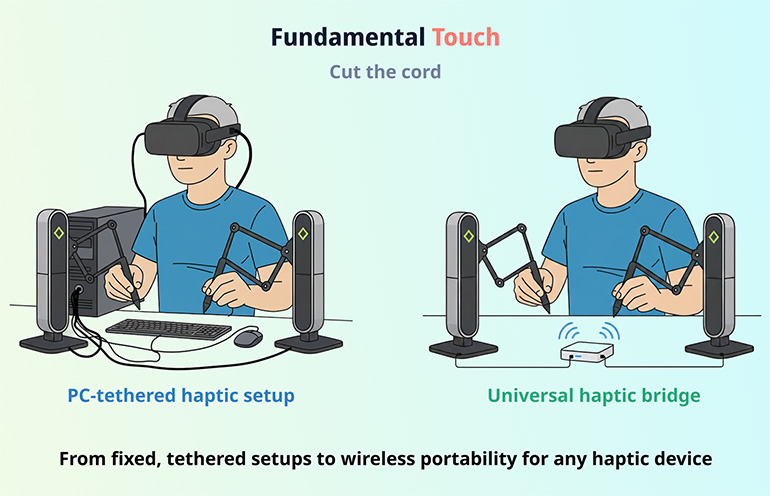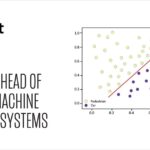The new Fundamental Touch software is intended to enable precise, untethered haptics. Source: Fundamental XR
Tactile feedback could be useful in multiple applications, but the sensors traditionally require tethers. Fundamental XR today announced the availability of Fundamental Touch, a wireless platform brining haptics beyond healthcare into industries including robotics, industrial training, automotive, aerospace, retail, and gaming.
“Touch is the missing dimension in human–machine interaction, and precision kinesthetic haptics finally unlocks its full potential by going wireless,” said Richard Vincent, founder and CEO of Fundamental XR. “Fundamental Touch removes the physical tether, giving users the mobility and performance parity they need to train, explore, and operate in ways never before possible.”
Fundamental XR said its immersive technologies including augmented, mixed, and virtual reality (AR/MR/VR), haptics, web, and app to help medical teams train and adopt complex procedures. The London-based company, formerly known as FundamentalVR, claimed that its platform can reduce onboarding time by more than 60%, boost surgical accuracy by 44%, and increase sales performance by 22%.
Fundamental XR said healthcare organizations use its spatial technologies to “accelerate skill acquisition, improve outcomes, and power the next generation of digital surgery.” They have delivered more than 50,000 sessions in over 30 countries, it added.
Fundamental Touch uses client-server model
Fundamental XR said its lifelike force-feedback simulations have helped train surgeons and clinicians for years. With the device-agnostic Fundamental Touch software, the company said it is “cutting the wires on haptic technology and expanding access to precision kinesthetic haptics architecture across a wide range of industries where freedom of movement, fidelity, and ease of setup are critical.”
Fundamental Touch is built on a wireless architecture that decouples haptic simulations from visual simulation and user interfaces. Traditionally, high-fidelity kinethetic haptics required a direct wire connection to a desktop computer, limiting movement and adoption, according to Fundamental XR.
The new offering solves this with a client–server model that enables mobility, scalability, and sub-100ms latency. Fundamental XR listed some specifications:
- Fundamental Touch: The software runs on a dedicated server or “haptic engine.” It interprets serialized simulations sent from the headset or input device and translates user actions such as button clicks or scene changes into realistic haptic feedback.
- Network layer: A peer-to-peer communication layer connects the headset or input device and server, ensuring low-latency, bi-directional data exchange for real-time force feedback, said the company.
- Haptic server: A single-board computer or embedded device hosts the software. It connects directly to haptic devices such as gloves, arms, pens, or suits and is designed to be embedded into them over time.
- Output devices: Clients include XR headsets like Apple Vision Pro and Meta Quest, robotic platforms such as Boston Dynamics‘ Spot quadruped, or gaming peripherals. They handle the visual rendering and communicate wirelessly with the haptic server for synchronized feedback.
“With this architecture, Fundamental Touch becomes a plug-and-play layer for wireless haptics, enabling developers, trainers, and operators to create rich tactile simulations that were previously impossible without wires,” said Fundamental XR.
Fundamental XR reaches across industries
“Fundamental Touch is set to redefine how humans interact with machines across industries, unlocking new possibilities where the sense of touch and simulated sensations transform experiences and enhance performance,” Fundamental XR asserted.
The company said that teleoperators of robots and drones can “feel what the robot feels” while controlling machines in hazardous or remote environments, from nuclear facilities to deep-sea missions and space exploration. The software could also help with imitation learning for training AI models and humanoid robots.
Fundamental XR also noted that its high-fidelity kinesthetic haptics can feed digital twins and simulations running on standalone XR devices, “reducing friction and cost” while increasing precision. The simulations can then be used in industrial training, healthcare, and automotive and aerospace instruction.
In addition, wireless haptics can help ensure operator safety for emergency, defense, and industrial applications, such as search and rescue, explosive ordnance disposal (EOD), and hazardous material handling with mobile manipulators. Finally, Fundamental Touch could benefit artists and gamers, said Fundamental XR.
“The launch of Fundamental Touch marks a crucial step in the evolution of immersive technology,” the company said. “By removing the tether, Fundamental XR is delivering total user freedom, high-fidelity force feedback, and broad platform compatibility, ushering in a new era of human–machine interaction that stretches across medicine, industry, mobility, commerce, and entertainment.”




























